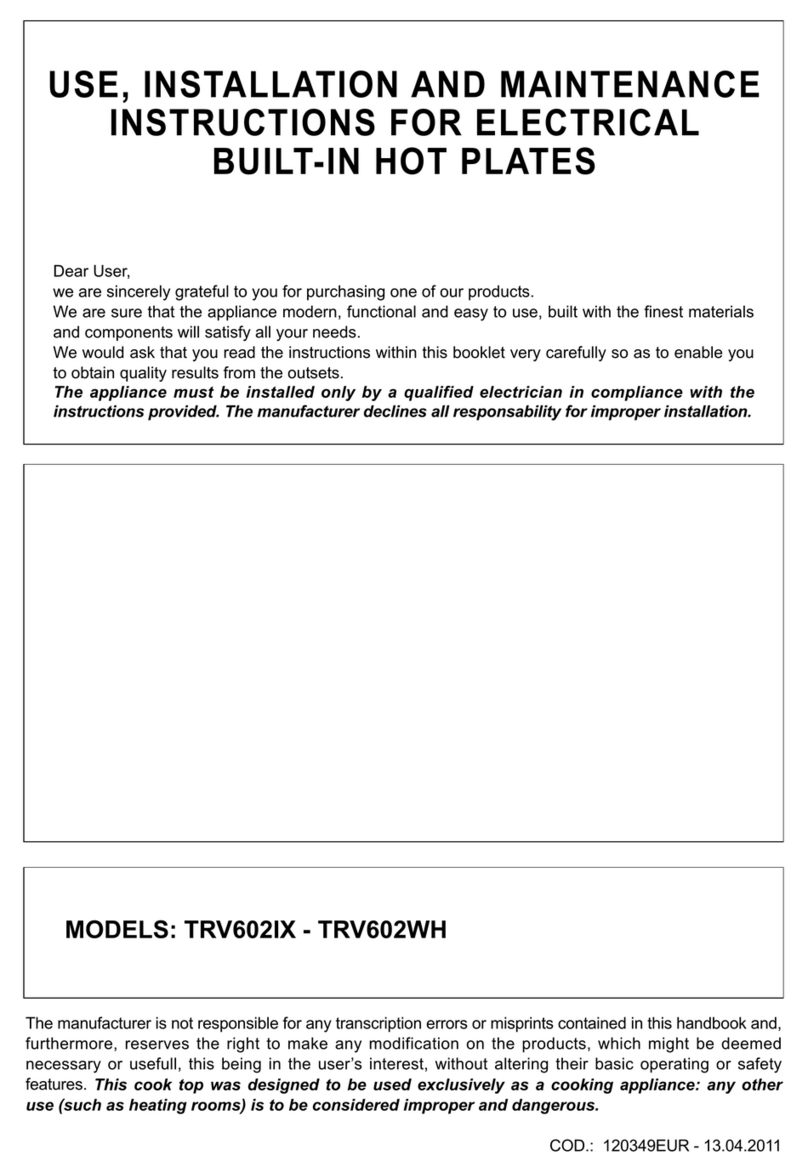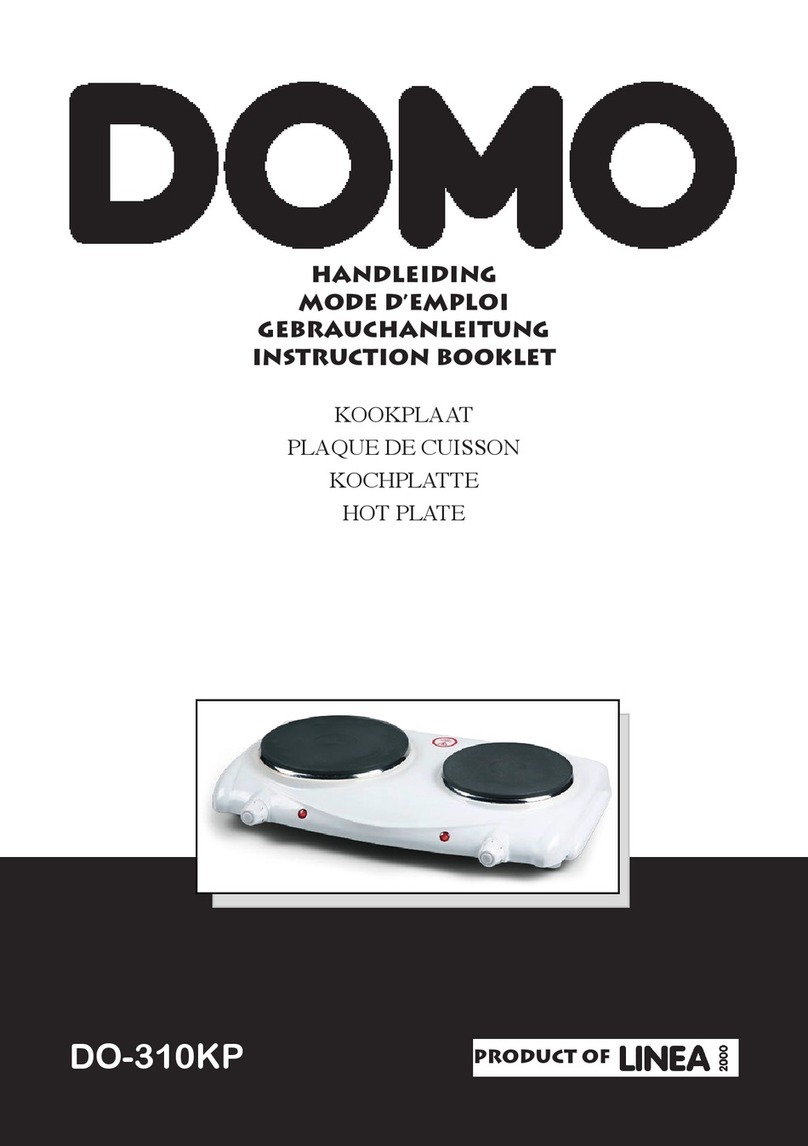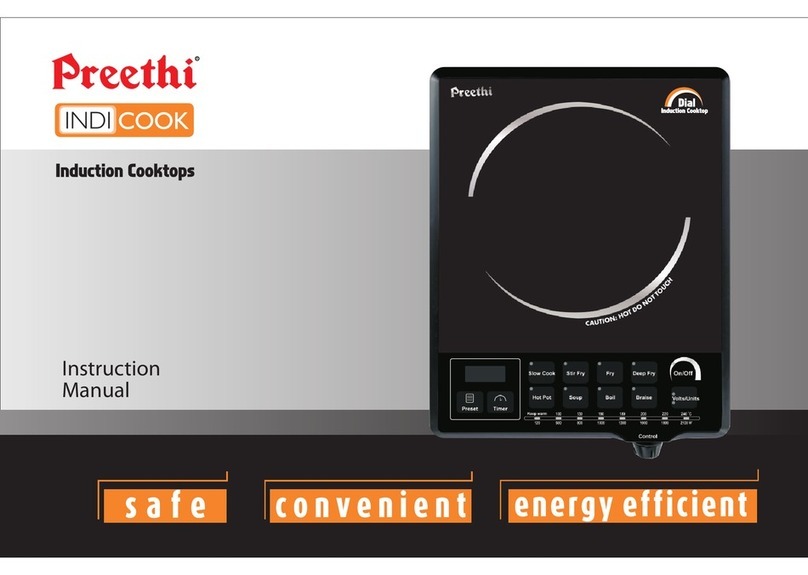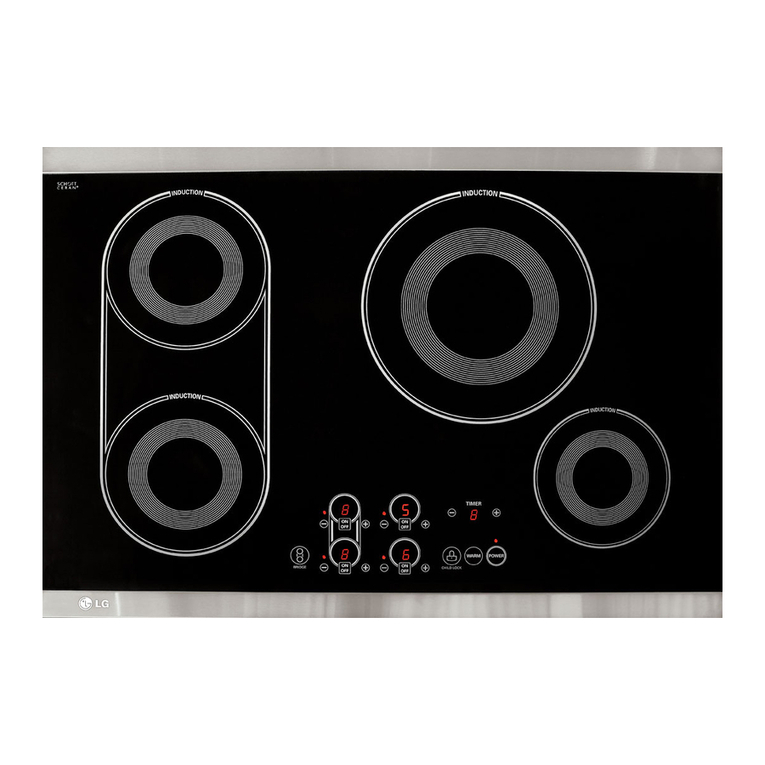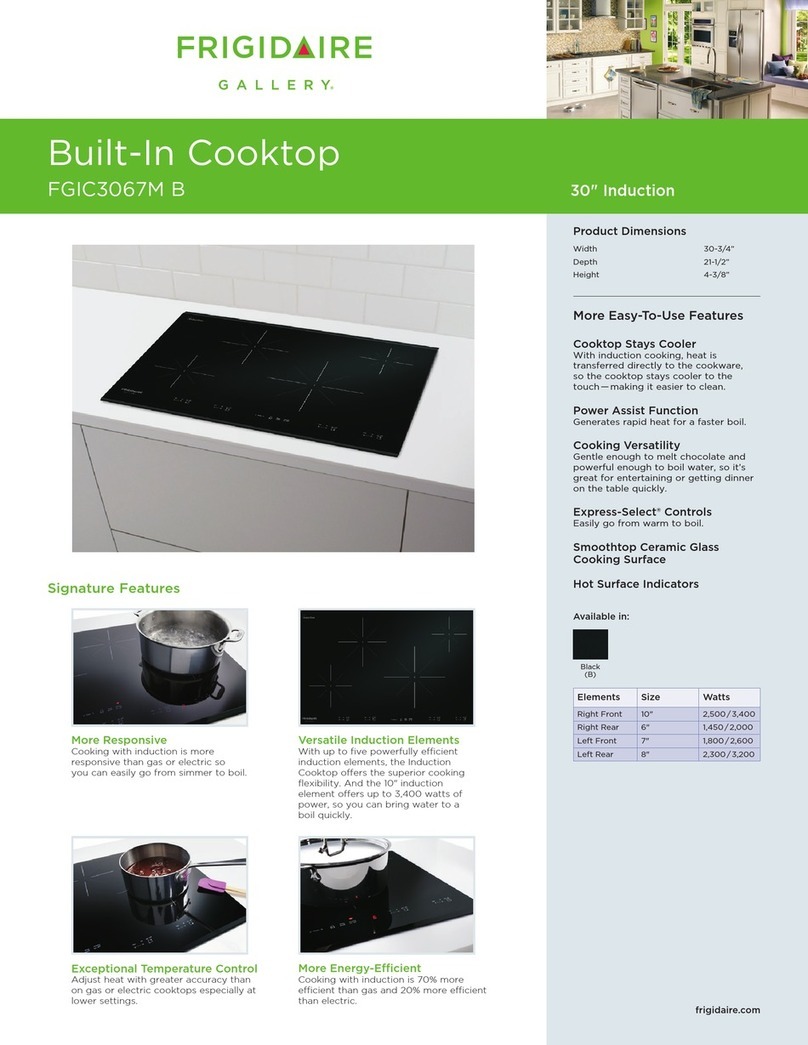Trieste built-in cooktops User manual

INSTRUCTIONS BOOKLET
built-in cooktops


Important warnings and tips for use
♦ IMPORTANT! This manual constitutes an integral part of the appliance. It must be kept intact
and within easy reach during the entire life of the cooktop. Please carefully read this manual
and all the instructions contained herein before using the appliance. Keep any spare parts
supplied with the appliance. Installation must be carried out by a qualified technician and in
compliance with current regulations. This appliance is intended solely for domestic use and is
designed for the following functions: cooking and reheating food. Any other use is
considered as improper.
The manufacturer declines all liability resulting from poor installation, tampering,
inexpert use and use for purposes other than those specifically stated.
♦ Check that the appliance has not been damaged during transport.
♦ Keep all packaging materials (plastic bags, polystyrene foam, nylon, etc.) away from children,
as they are potentially dangerous.
♦ The packaging material is recyclable, and marked with the recycling symbol .Dispose of
the appliance responsibly.
♦ This appliance must be used by adults only. Make sure children do not touch the controls
or play with the appliance.
♦ Installation and gas/electrical connections must be carried out by a qualified technician in
accordance with the manufacturer's instructions and in full compliance with current laws and
safety regulations.
♦ Electrical safety can only be guaranteed if the product is connected to a suitable earth
connection.
♦ It is dangerous to modify or attempt to modify the appliance. In the event of a malfunction, do
not attempt to repair the appliance yourself, but contact a qualified technician.
♦ After using the cooktop, ensure the indicator on the knob is turned to the "off" position and
close the mains gas delivery tap or the gas cylinder tap.
♦ Should you decide not to use the appliance any longer, before scrapping it make it unusable in
accordance with current environmental health and safety laws, ensuring any parts which might
constitute a danger to children are rendered harmless.
♦ The appliance data plate, with technical specifications, is positioned at a visible point under the
safety cover and is also enclosed with this manual. The data plate below the safety cover
must under no circumstances be removed.
♦ Illustrations for the use of the appliance are grouped together at the end of this manual.
Declaration of Conformity
This appliance conforms to the following EC directives:
− 90/396/EEC “Gas safety requirements”
− 73/23/EEC “Low voltage”
− 89/336/EEC “Electromagnetic compatibility”
− 93/68/EEC “General Standards”
− 89/109/EEC “Materials or objects destined to come into contact with foodstuffs”
GLASS LID
If the cooktop has a glass lid, observe the following rules:
♦ Never place hot pans on the lid when it is lowered.
♦ Remove any liquids spilled on the lid before raising it.
These instructions are valid only for those countries whose ID
initials appear on the data plate found on the instructions
handbook and on the appliance.
1

♦ The lid may break if heated. Switch off all burners and electric hotplates and wait until they cool
before lowering the lid.
COOKTOP SPECIFICATIONS
Warnings:
This appliance is designed to be built into a housing unit.
♦ The installation class is type 3 for gas and type Y for electric parts.
♦ Housing units must be designed to withstand temperatures of up to 90°C or over.
♦ For correct installation, refer to the relevant paragraph and reference drawings.
♦ The use of a gas cooking appliance produces heat and humidity in the room in which it is
installed. Ensure the kitchen is well ventilated: keep natural ventilation openings open, or install
a mechanical ventilation device (extractor hood with exhaust duct). In the case of intensive or
prolonged use of the appliance it may be necessary to provide additional ventilation, for
example, by opening a window, or more efficient ventilation, for example by increasing the
hood speed.
This handbook is valid for several types of cooktop. Refer to the data plate on the back in order to
identify the model (Mod. Tc) that corresponds to your appliance. These initials, together with the
instructions inthefollowing paragraphs andtheillustrations atthebackof the manual (Fig1-33)will
show the particular composition of your appliance.
An Example:
Approval mark
Type: P......
COOKING POINTS
60 cm cooktops with side controls
Mod: P6(**)L1 (Fig. 1)
1. Semirapid right burner (SR)
2. Electric hotplate ø 145
3. Rapid burner (R)
4. Auxiliary burner (A)
Mod: P6(**)L2
(Fig. 2)
1. Semirapid right burner (SR)
2. Semirapid left burner (SR)
3. Triple crown burner (TC)
4. Auxiliary burner (A)
Mod: P6(**)L3
(Fig. 3)
1. Semirapid right burner (SR)
2. Triple crown burner (TC)
3. Auxiliary burner (A)
Mod: P6(**)L4
(Fig. 4)
1. Semirapid right burner (SR)
2. Semirapid left burner (SR)
3. Rapid burner (R)
4. Auxiliary burner (A)
Mod: P6(**)L8
(Fig. 5)
1. Electric hotplate ø 145
2. Semirapid left burner (SR)
3. Triple crown burner (TC)
4. Auxiliary burner (A)
Mod: P6(**)L9
(Fig. 6
)
1. Rapid burner (R)
2. Electric hotplate ø 145
3. Electric hotplate ø 180
4. Auxiliary burner (A)
60 cm cooktops with front controls
Mod: P6(**)F1
(Fig. 7)
1. Rapid burner (R)
2. Electric hotplate ø 145
3. Semirapid front burner (SR)
4. Auxiliary burner (A)
Mod: P6(**)F2
(Fig. 8)
1. Triple crown burner (TC)
2. Semirapid rear burner (SR)
3. Semirapid front burner (SR)
4. Auxiliary burner (A)
Mod: P6S(**)F4
(Fig. 9)
1. Rapid burner (R)
2. Semirapid rear burner (SR)
2

3. Semirapid front burner (SR)
4. Auxiliary burner (A)
70 cm cooktops with front controls
Mod: P7(**)F3
(Fig. 10)
1. Triple crown burner (TC)
2. Semirapid rear burner (SR)
3. Auxiliary burner (A)
Mod: P7(**)F4
(Fig. 11)
1. Auxiliary burner (A)
2. Rapid burner (R)
3. Semirapid rear burner (SR)
4. Semirapid front burner (SR)
Mod: P7(**)F5
(Fig. 12)
1. Auxiliary burner (A)
2. Rapid burner (R)
3. Semirapid rear burner (SR)
4. Semirapid front burner (SR)
5. Triple crown burner (TC)
Mod: P7(**)F6
(Fig. 13)
1. Auxiliary burner (A)
2. Rapid burner (R)
3. Semirapid rear burner (SR)
4. Semirapid front burner (SR)
5. Fish kettle burner (P)
Mod: P7(**)F7
(Fig. 14)
1. Auxiliary burner (A)
2. Rapid burner (R)
3. Semirapid rear burner (SR)
4. Semirapid front burner (SR)
5. Electric hotplate ø 145
90 cm cooktops with front controls
Mod: P9(**)F2
(Fig. 15)
1. Triple crown burner (TC)
2. Semirapid left burner (SR)
3. Semirapid right burner (SR)
4. Auxiliary burner (A)
Mod: P9(**)F3
(Fig. 16)
1. Triple crown burner (TC)
2. Semirapid right burner (SR)
3. Auxiliary burner (A)
Mod: P9(**)F4
(Fig. 17)
1. Rapid burner (R)
2. Semirapid left burner (SR)
3. Semirapid right burner (SR)
4. Auxiliary burner (A)
Mod: P9(**)F5
(Fig. 18)
1. Rapid burner (R)
2. Semirapid left burner (SR)
3. Semirapid right burner (SR)
4. Auxiliary burner (A)
5. Triple crown burner (TC)
Mod: P9(**)F6
(Fig. 19)
1. Rapid burner (R)
2. Semirapid left burner (SR)
3. Semirapid right burner (SR)
4. Auxiliary burner (A)
5. Fish kettle burner (P)
Mod: P9(**)FB
(Fig. 20)
1. Triple crown burner (TC)
2. Semirapid left burner (SR)
3. Semirapid right burner (SR)
4. Auxiliary burner (A)
5. Fish kettle burner (P)
Mod: P9(**)FC
(Fig. 21)
1. Rapid burner (R)
2. Semirapid left burner (SR)
3. Electric hotplate ø 145
4. Electric hotplate ø 180
5. Auxiliary burner (A)
6. Semirapid right burner (SR)
Mod: P9(**)FD
(Fig. 22)
1. Left triple crown burner (TC)
2. Auxiliary burner (A)
3. Right triple crown burner (TC)
Mod: P9(**)FN
(Fig. 23)
1. Rapid left burner (R)
2. Semirapid left burner (SR)
3. Central rapid burner (R)
4. Central semirapid burner (SR)
5. Auxiliary burner (A)
6. Semirapid right burner (SR)
90 cm cooktops with side controls
Mod: P9(**)L5
(Fig. 24)
1. Auxiliary burner (A)
2. Rapid burner (R)
3. Triple crown burner (TC)
4. Semirapid left burner (SR)
5. Semirapid right burner (SR)
Mod: P9(**)LB
(Fig. 25)
1. Auxiliary burner (A)
2. Triple crown burner (TC)
3. Fish kettle burner (P)
4. Semirapid left burner (SR)
5. Semirapid right burner (SR)
Mod: P9(**)LC
(Fig. 26)
1. Auxiliary burner (A)
2. Electric hotplate ø 180
3. Rapid burner (R)
4. Semirapid left burner (SR)
5. Electric hotplate ø 145
6. Semirapid right burner (SR)
Mod: P9(**)LN
(Fig. 27)
1. Auxiliary burner (A)
2. Central rapid burner (R)
3. Rapid left burner (R)
4. Semirapid left burner (SR)
5. Central semirapid burner (SR)
3

USING THE COOKTOP
Gas burners
The deliveryof gas totheburnersiscontrolled bythe knobs showninfig. 36that inturncontrol the
taps. The symbols, depending on the various versions, may be printed on the knobs or on the
control panel. By moving the indicator to coincide with the printed symbols, the following
adjustments can be made:
OTap closed, no gas delivery
Maximum capacity, maximum gas delivery
Minimum capacity, minimum gas delivery
Burner ignition
- Burners without safety valve
To light burners without electric ignition, or to light those with ignition during a power cut, place a
naked flame next to the top of the burner, press the corresponding knob down and turn anti-
clockwiseuntilthesymbolcoincides with the reference mark on the control panel.
For minimum gas delivery, turn the knob until the indicator points to the small flame.
The setting must always be positioned between the maximum and minimum, and never
between the maximum setting and the off position.
To switch the burner off, turn the knob clockwise to the position
“tap closed”
- Burners with electric ignition
Models with ignition switch
To light one of the burners, press the ignition switch and turn the corresponding knob to the
maximum delivery position (symbol ). Hold the switch down until the burner lights, then adjust the
flame by turning the knob to obtain the desired intensity.
Models with ignition incorporated in the control knobs
These models are identified by the symbol next to the symbol ( Maximum delivery).
To light one of the burners, press the knob down and turn it to the maximum delivery position,
holding down until the burner lights. Next adjust the flame by turning the knob to obtain the desired
intensity.
6. Semirapid right burner (SR) Mod: P3(**)FH (Fig. 31)
1. Electric hotplate ø 145
2. Electric hotplate ø 180
Domino Cooktops
Mod: P3(**)FE (Fig. 28)
1. Triple crown burner (TC)
Mod: P3(**)FM (Fig. 32)
1. Hotplate ø 145
2. Hotplate ø 180
3. Appliance ON indicator
4. Residual heat indicator
Mod: P3(**)FF (Fig. 29)
1. Auxiliary burner (A)
2. Rapid burner (R) Mod: P3(**)FR (Fig. 33)
1. Grill plate measuring ø350 x200
3.Power signal
4. Residual heat signal
Mod: P3(**)FG (Fig. 30)
1. Fish kettle burner (P)
4

Note:
If the particular nature of the local gas supply makes it difficult to ignite the burners with the knob
turned to the maximum setting, repeat the operation without a pan in position and with the knob
turned to the minimum setting.
- Burners with safety valves
Some models are equipped with safety valves which automatically shut off the gas delivery in the
event the burner should, for any reason, go out.
To relight the burner, turn the knob to position Oand repeat the ignition procedure explained in the
following paragraphs.
Using the burners
Depending on the type of electric ignition fitted, proceed as follows:
)For models fitted with ignition incorporated in the knobs, turn the gas tap knob to the maximum
delivery position, then press and hold down for about 4÷5 seconds. Release the knob and
adjust the flame by turning the knob to the desired intensity.
)'Warning':
The ignition device must not be used for more than 15 seconds.
If after this length of time the burner does not light, or if it goes out again accidentally,
wait 1 minute before trying to ignite the burner again.
)For models fitted with ignition switch, turn the gas tap knob to the maximum delivery position,
then press the ignition switch and the knob, holding down for about 4÷5 seconds. Then release
the knob and adjust the flame by turning the knob to the desired intensity.
Using the grids
The panstand grids are designed to make the appliance easy and safe to use. Always check the
panstand grids are properly positioned before using the appliance. Furthermore, always check the
protective rubber feet are all present and correctly positioned.
Grid for small pots or pans (Fig. 34)
This is placed on top of the auxiliary burner grid (the smallest one) when pots or pans of reduced
diameter are used, to avoid unbalancing.
Special“WOK” supportgrid(Fig. 35optional)
This is placed on top of the triple crown burner when using a “WOK” (concave bottom pan). In
order to prevent serious malfunction of the burner,
never use a wok without this special grid
and never use the wok grid for flat bottomed pans
Choosing the right burner
The symbols stamped on the controlpanel (fig.36)nextto the knobs indicate whichknob
corresponds to which burner. To choose the most suitable burner, take into account the diameter of
the pan as well as the pan capacity (see table).
The diameter of the pan must be proportionate to the burner power in order to ensure high yield.
Pan diameter
Burner
Minimum diameter
Maximum diameter
Auxiliary 60 mm
(with
reducer)
140 mm
Semirapid 160 mm 200 mm
Rapid 200 mm 240 mm
Triple crown 240 mm 260 mm
Fish kettle Maximum dimensions: 140X350 mm
5

Electric hotplates
Switching on the hotplate
To switch on the electric hotplate, turn the knob to the desired position.
Numbers1to 6or 1to 11 (fig. 37),depending on whether the cooktop is fittedwithapower switch
or regulator, indicate the settings in progressing temperature (See Table).
When the electric hotplate is in operation an indicator led on the control panel lights up.
Using the electric hotplate
Once the pan has reached the boil, adjust the power to suit the intensity of heating required,
bearing in mind that the hotplate will continue to emit heat for several minutes after being switched
off.
When using the hotplate, remember:
)Never under any circumstances use the hotplate without a suitable receptacle. Idle
operation of the hotplate, especially for prolonged periods of time, can cause fires.
)
Take all precautions possible to avoid spilling liquids onto the hotplate when it is hot.
)Use flat bottomed pans only with a diameter such as covers the entire burner surface.
Knob position
Type of cooking
00
Off
1
2
1
2For melting (butter or chocolate)
2
2
3
4
For keeping food warm or reheating small
amounts of liquids
3
4
5
6
Reheating larger quantities, whipping creams
and sauces
47
8
Simmering, soups, pasta, risottos,
continuation of steaming, cooking steaks and
fries in general
4
5
8
9
10
Browning meats, roast potatoes, fried fish and
for bringing large quantities of water to the boil
611
12 Brisk frying, griddling steaks etc.
Type of hotplate
The cooktop may be equipped with a conventional or rapid hotplate.
The conventional hotplate is entirely black, while the rapid hotplate has a red dot in the centre.
For technical specifications refer to
“Cooktop Specifications– Cooking point”
Essentially, the rapid hotplate differs from the conventional one because it offers :
)Greater power.
)More rapid reaching of desired temperature.
Glass-ceramic cooktop.
The glass-ceramic cooktop permits rapid vertical transmission of heat from the heating element
below the cooktop to the pots or pans placed on top of it.
Heat does not spread horizontally, thus at a distance of just a few centimetres from the cooking
zone, the glass remains ” cool” to the touch.
The cooking zones are controlled by a power switch with 7 different positions or by a continuous
regulator with 13 positions,as shownin figure37
Never cook food directly on the electric hotplates
;
always use suitable pots or containers
6

The intensity of heating for each zone can be adjusted progressively from “0” (off) to “6” 0R “11”
(max).
When the cooktop is on the indicator light remains lit.
When the temperature of the cooking zone is above 70°C, the corresponding “residual heat”
indicator lamp lights up to warn that the zone is hot.
This lamp remains lit even after the cooking zone is switched off, to signal that the zone is still hot.
Residual heat persists for a relatively prolonged period of time after the cooking zone has been
switched off.
During this time, avoid touching the cooking zone and take precautions to ensure children
cannot touch it.
The indicator lamp switches off automatically once the temperature of the cooking zone falls below
70°C.
Safety tips for using the cooktop
)Before switching on, check which knob controls the desired cooking zone.
It is best to place the pot or pan on the cooking zone before switching on, and remove it only
after switching off.
)Use only flat bottomed pans with a regular surface (exercise caution with cast iron pans).
Irregular bottoms can scratch the glass-ceramic surface. Check the bottom is clean and dry
)Do not use the cooktop if the surface is broken or damaged.
)Bear in mind that the cooking zones remain hot for a relatively long time (about 30 min.) after
switching off.
)Do not allow heavy or sharp objects to fall on the glass-ceramic cooktop.
)
If you find a crack on the cooktop, disconnect the appliance from the mains electricity
immediately and contact the After-sales Service.
)Do not stare at the halogen lamps on the cooktop.
)Never cook food directly on the glass-ceramic cooktop; always use suitable pots or containers.
Types of cooking zones
“3 circuit” radiant zone
The heating element comprises 3 electric elements which can function together or separately
depending on the position of the switch with 7 positions or the 0-11 power regulator.
“hi-light” radiant zone
The heating element comprises a tape heating coil which reaches working temperature extremely
quickly.
This zone is controlled by a continuous power regulator.
Halogen zone
The heating element comprises 2 halogen lamps and an electric element.
This zone reaches working temperature instantly.
It is also controlled by a continuous power regulator.
7

INSTALLATION INSTRUCTIONS
Important!
These instructions are intended for qualified technicians.
The appliance must be installed correctly, in compliance with current laws.
Before carrying out any operation on the appliance, it must be disconnected from the
electricity supply.
Fitting the appliance in the worktop
The cooktop may be fitted into any worktop, as long as it is heat resistant (minimum temperature of
90°C).
The dimensions of the hole to be made in the worktop and the minimum distances between rear
and side walls andthoseabovetheapplianceareshowninfigures 38and 39.
Bear in mind that:
)If the cooktop is installed without an oven below it, a separator panel must be placed between
the bottom of the cooktop and the housing below it, at a minimum distance of 10 mm.
)If the cooktop is installed over an oven, place a separator panel at a minimum distance of 15
mm and follow the oven manufacturer's instructions, ensuring nonetheless sufficient aeration
as specified in fig. 40.
In anyevent, the electrical connection of the twoappliances must
be carried out separately,
both for electrical purposes and to facilitate removal.
It is advisable to use an oven equipped with an internal forced cooling system.
Fixing the cooktop
To fix the cooktop in the housing, proceed as follows:
)Position the special gasket supplied along the outer perimeter of the worktop, following the
diagram showninfig. 38,sothattheends of the gasket meet exactlywithout overlapping.
)Position the cooktop into the worktop, taking care to ensure it is placed exactly in the centre.
)Fix the cooktop to theworktop using the specialbrackets supplied,as shown infig. 41.
Correct installation of the sealing gasket ensures complete protection against infiltration of liquids.
Installation area and removal of combustion fumes
)
The appliance must be installed and operated in suitable areas, and in compliance with
current laws.
The installation technician must observe current laws governing ventilation and removal of
combustion fumes.
The air required for combustion is 2m
/h per kW of power (gas) installed.
Installation area
In the room where the gas appliance is installed, there must be a sufficient natural air supply to
allow the gas to burn correctly.
The natural flow of air must take place through an opening made on an outside wall of the room
and having a working section of at least 100 cm2(A). In the case of appliances without safety
valves,thisopening musthave aminimumworking section of 200 cm2
(fig. 42).
This opening must be made in such a way that it cannot be obstructed from inside or outside. It
should be positioned near floor level, preferably on the side opposite the fume exhaust devices.
If it is not possible to make the necessary openings, the air can be supplied from an adjacent,
suitably ventilated room, as long as this room is not a bedroom, a dangerous area or a low-
pressure area.
Removal of combustion fumes
Combustion fumes produced by gas appliances must be removed by means of a hood connected
directlyeither to an exhaustductor totheoutside (fig. 42).
8

If a hood cannot be installed, an electric extractor fan must be fitted to the outside wall or the
window.
This electric extractor fan must have a sufficient capacity to guarantee a change of air of the
kitchen of at least 3-5 times its volume.
Components showninfig. 4
A : Opening for air supply
C : Hood for exhaust removal of combustion fumes
E : Electric extractor fan for removal of combustion fumes
Connection to gas supply
)Before installation, make sure the type and pressure of the local gas supply are
compatible with the cooktop settings. To do this, check the data on the appliance data
plate on the cooktop as well as on this handbook.
The gas connection must be carried out by a qualified technician in compliance with local current
regulations.
If using metal hoses, ensure these do not come into contact with any movable parts and are at no
point crushed.
Carry out the connection in such a way as does not cause any stress whatsoever on the appliance.
The gas supply connector is threaded G½”.
For ISO R7 connections, the gasket is not required.
For ISO R228 connections, the washer supplied must be fitted.
)After connection operations, check for leaks using a soapy solution.
Electricalconnection (Fig. 44)
Before connecting the appliance to the electricity supply, check that the voltage corresponds to that
on the data plate and that the power supply cable is suitable for the appliance load also stated on
the data plate.
If the appliance is connected directly to the mains, fit an all-pole disconnect switch with minimum
contact gap of 3 mm, adequate for the appliance load and complying to regulations.
)Do not use reducers, adapters or switches for connection to the mains, since these
could overheat and cause burns.
)Regulations require that the appliance is earthed. The manufacturer declines all liability
resulting from failure to observe this regulation.
If the power cable must be replaced, use a cable having identical characteristics to the original
supplied by the manufacturer, suitable for the load and temperature (type T90°C). This is available
from After-sales service. Furthermore, the end of the power cable to be connected to the appliance
must have the Yellow-Green earth conductor 20 mm longer than the other conductors.
Refer to the table below for the size of the power cable
Type of cooktop Size
Only gas burners 3X0.50 mm2
With electric power up to 1000W 3 X 0.75 mm2
With electric power above 1000W 3 X 1.5 mm2
ADJUSTMENT TO DIFFERENT TYPES OF GAS
If a different type of gas from the one indicated on the rating plate is used, the injectors must be
replaced.
If spare injectors are not supplied with the appliance, they are available from the After-sales
service.
For the choice of replacement injectors, refer to the injectors table.
The injectors are identified by their diameter, which is expressed in hundredths of mm, stamped on
the body of the injector itself.
9

Remove the grids and burner caps from the cooktop
Using asocket wrench,replacethe injectors“J”(fig. 43)with the suitable ones for the gas
used.
Replace the burners.
The burners do non require primary air adjustment.
Adjustment of minimum setting
After replacing the injectors, light the burner and remove the knob. Turn the tap to the minimum
setting and insert a screwdriver in the rod: tighten to reduce the flame, loosen to increase the
flame. (fig. 43)
For gas G30/G31, tighten the adjustment screw fully
The flame must be small, uniform and regular all around the burner crown.
Finally, check that the flame does not go out by rapidly turning the tap from the maximum setting to
the minimum. For burners with a safety device, check that the flame slightly licks the thermocouple.
Make sure that the adjustment is correct by leaving the burner alight for a few minutes. If it goes
out, increase the minimum setting.
CLEANING
To maintain the cooktop in optimum condition, clean it regularly after each use, allowing it to cool
before cleaning.
Never remove the knobs from their seats
Enamelled parts
All enamelled parts should be cleaned with a sponge and soapy water or specific detergents.
Never use abrasive cleaning products. Dry thoroughly after cleaning.
Stainless steel top
The stainless steel top should be cleaned with a damp cloth and proprietary detergents
commercially available.
After rinsing, dry preferably with a chamois leather.
Grids
The enamelled panstand grids of the cooktop are dishwasher safe.
Stainless steel panstand grids may take on a bluish tinge on parts around the burners as a result of
the high temperatures. This effect can be reduced by using commercially available steel wool pads.
Burners
The burners, comprising two parts, can be removed and cleaned using suitable detergents. After
cleaning, dry the burners thoroughly and reposition them carefully in their seats.
In models withelectric ignition, alwayscheckthat theelectrode “E”(fig. 45)isclean.
In models withsafetydevice, clean the probe “T”(fig. 45)in order toallowregular operationofthe
safety valve. Both the electrode and probe must be cleaned with care.
Upon completion of cleaning, replace the burners accurately in their seats.
To prevent damaging the electric ignition, avoid using it when the burners are not in place.
Electric hotplates
The electric hotplates should be cleaned when they are only slightly warm.
Clean with a damp cloth, then finish off with a cloth dampened with mineral oil.
Replacing the injectors
10

MAINTENANCE
The appliances do not require any particular maintenance, nonetheless it is advisable to have them
checked at least once every two years.
If the knobs become difficult to turn, or if there is a smell of gas, shut the gas supply tap and call
After-sales service.
Faulty taps must be replaced along with their gasket.
11

Cat.: II 2H 3+ IT GB ES PT CH IE
Tipo di gas/ gas type/ type de gaz/ tipo de gas/ tipo
de gás/ gaz type G20
Pressione del gas/ gas pressure/ pression gaz/
presion gas/ pressão gas 20 mbar
Bruciatori/ burners/
bruleurs/
quemodores/ bocas
de gás/ branders
Portata/power
inputs/débit
gas/capacidad/va
zão /debiet
Max (kW)
Portata/power
inputs/débit
gas/capacidad/va
zão /debiet
Min (kW)
Ø
Iniettore/injectors/
injecteur/inyector/
injector/sproeier
A 1.00 0.30 0.72
SR 1.75 0.44 0.97
R 3.00 0.75 1.15
TC 3.30 1.50 1.24
P/F 2.90 1.50 1.20
Tipo di gas/ gas type/ type de gaz/ tipo de gas/ tipo
de gás/ gaz type G30/G31
Pressione del gas/ gas pressure/ pression gaz/
presion gas/ pressão gas 28-30/37 mbar
Bruciatori/ burners/
bruleurs/
quemodores/ bocas
de gás/ branders
Portata/power
inputs/débit
gas/capacidad/va
zão /debiet
Max (kW)
Portata/power
inputs/débit
gas/capacidad/va
zão /debiet
Min (kW)
Ø
Iniettore/injectors/
injecteur/inyector/
injector/sproeier
A 1.00 0.30 0.50
SR 1.75 0.44 0.65
R 3.00 0.75 0.85
TC 3.30 1.50 0.91
P/F 2.90 1.50 0.85
Only for Australian and New Zealand
Tipo di gas/ gas type/ type de gaz/ tipo de gas/ tipo
de gás/ gaz type G20
Pressione del gas/ gas pressure/ pression gaz/
presion gas/ pressão gas 1.0 kPa
Bruciatori/ burners/
bruleurs/
quemodores/ bocas
de gás/ branders
Portata/power
inputs/débit
gas/capacidad/va
zão /debiet
Max (kW)
Portata/power
inputs/débit
gas/capacidad/va
zão /debiet
Min (kW)
Ø
Iniettore/injectors/
injecteur/inyector/
injector/sproeier
A 1.00 0.30 0.90
SR 1.75 0.44 1.18
R 3.00 0.75 1.55
TC 3.30 1.50 1.60
P/F 2.90 1.50 1.55
Tipo di gas/ gas type/ type de gaz/ tipo de gas/ tipo
de gás/ gaz type G30/G31
Pressione del gas/ gas pressure/ pression gaz/
presion gas/ pressão gas 2.75 kPa
Bruciatori/ burners/
bruleurs/
quemodores/ bocas
de gás/ branders
Portata/power
inputs/débit
gas/capacidad/va
zão /debiet
Max (kW)
Portata/power
inputs/débit
gas/capacidad/va
zão /debiet
Min (kW)
Ø
Iniettore/injectors/
injecteur/inyector/
injector/sproeier
A 1.00 0.30 0.53
SR 1.75 0.44 0.69
R 3.00 0.75 0.90
TC 3.30 1.50 0.97
P/F 2.90 1.50 0.90
12

Other Country
Tipo di gas/ gas type/ type de gaz/ tipo de gas/ tipo
de gás/ gaz type G20
Pressione del gas/ gas pressure/ pression gaz/
presion gas/ pressão gas 20 mbar
Bruciatori/ burners/
bruleurs/
quemodores/ bocas
de gás/ branders
Portata/power
inputs/débit
gas/capacidad/va
zão /debiet
Max (kW)
Portata/power
inputs/débit
gas/capacidad/va
zão /debiet
Min (kW)
Ø
Iniettore/injectors/
injecteur/inyector/
injector/sproeier
A 1.00 0.30 0.72
SR 1.75 0.44 0.97
R 3.00 0.75 1.15
TC 3.30 1.50 1.24
P/F 2.90 1.50 1.20
Tipo di gas/ gas type/ type de gaz/ tipo de gas/ tipo
de gás/ gaz type G30/G31
Pressione del gas/ gas pressure/ pression gaz/
presion gas/ pressão gas 28-30/37 mbar
Bruciatori/ burners/
bruleurs/
quemodores/ bocas
de gás/ branders
Portata/power
inputs/débit
gas/capacidad/va
zão /debiet
Max (kW)
Portata/power
inputs/débit
gas/capacidad/va
zão /debiet
Min (kW)
Ø
Iniettore/injectors/
injecteur/inyector/
injector/sproeier
A 1.00 0.30 0.50
SR 1.75 0.44 0.65
R 3.00 0.75 0.85
TC 3.30 1.50 0.91
P/F 2.90 1.50 0.85
Tipo di gas/ gas type/ type de gaz/ tipo de gas/ tipo
de gás/ gaz type G110
Pressione del gas/ gas pressure/ pression gaz/
presion gas/ pressão gas 8 mbar
Bruciatori/ burners/
bruleurs/
quemodores/ bocas
de gás/ branders
Portata/power
inputs/débit
gas/capacidad/va
zão /debiet
Max (kW)
Portata/power
inputs/débit
gas/capacidad/va
zão /debiet
Min (kW)
Ø
Iniettore/injectors/
injecteur/inyector/
injector/sproeier
A 1.00 0.30 1.45
SR 1.75 0.44 1.85
R 3.00 0.75 2.60
TC 3.30 1.50 2.80
P/F 2.90 1.50 2.60
13

14

15

16

17

18
This manual suits for next models
33
Table of contents
Other Trieste Cooktop manuals
Popular Cooktop manuals by other brands
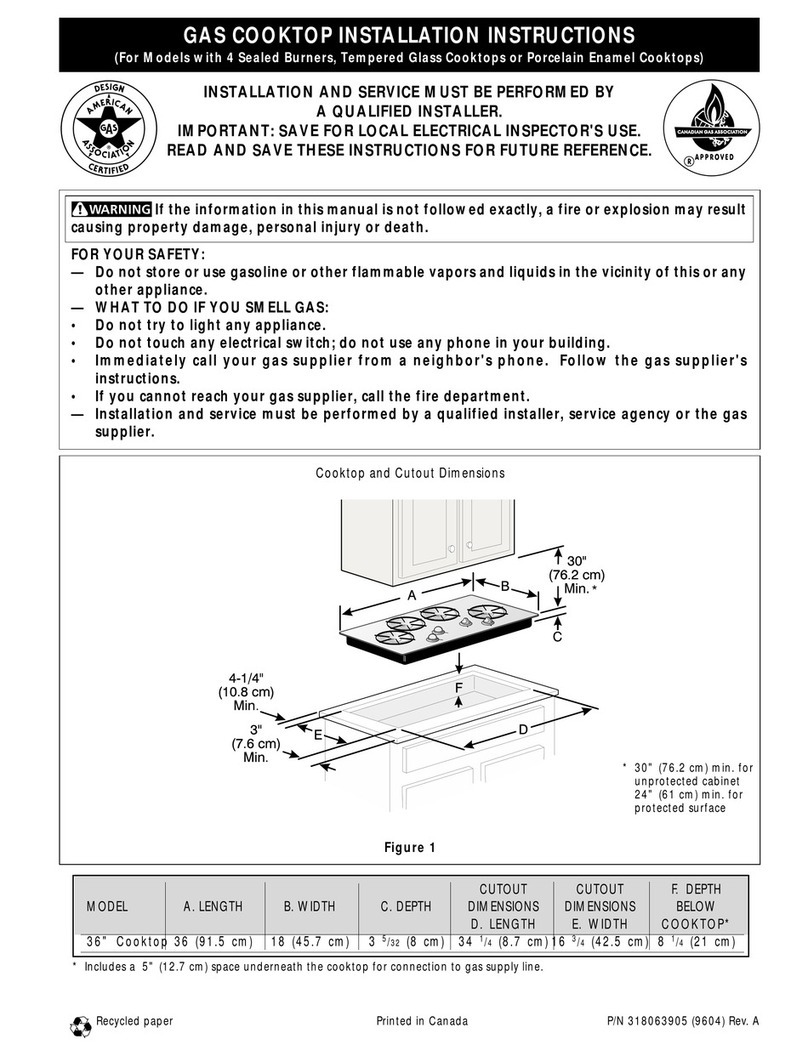
Frigidaire
Frigidaire FGC6X5XEWD installation instructions
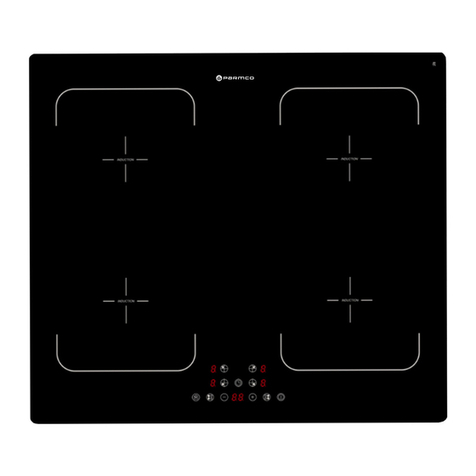
Parmco
Parmco HX-2-6NF-ZLIND Installation and operating instructions

KitchenAid
KitchenAid KGCP482KSS04 parts list
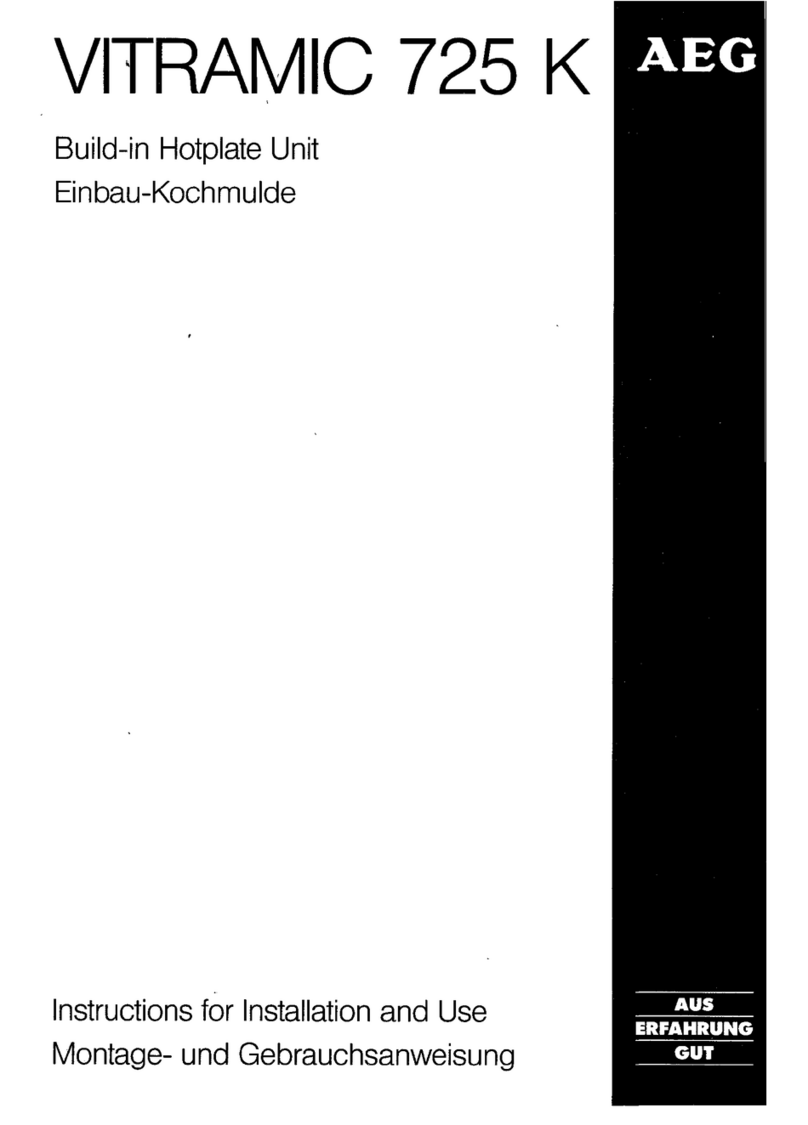
AEG
AEG VITRAMIC 725K Installation and use instructions
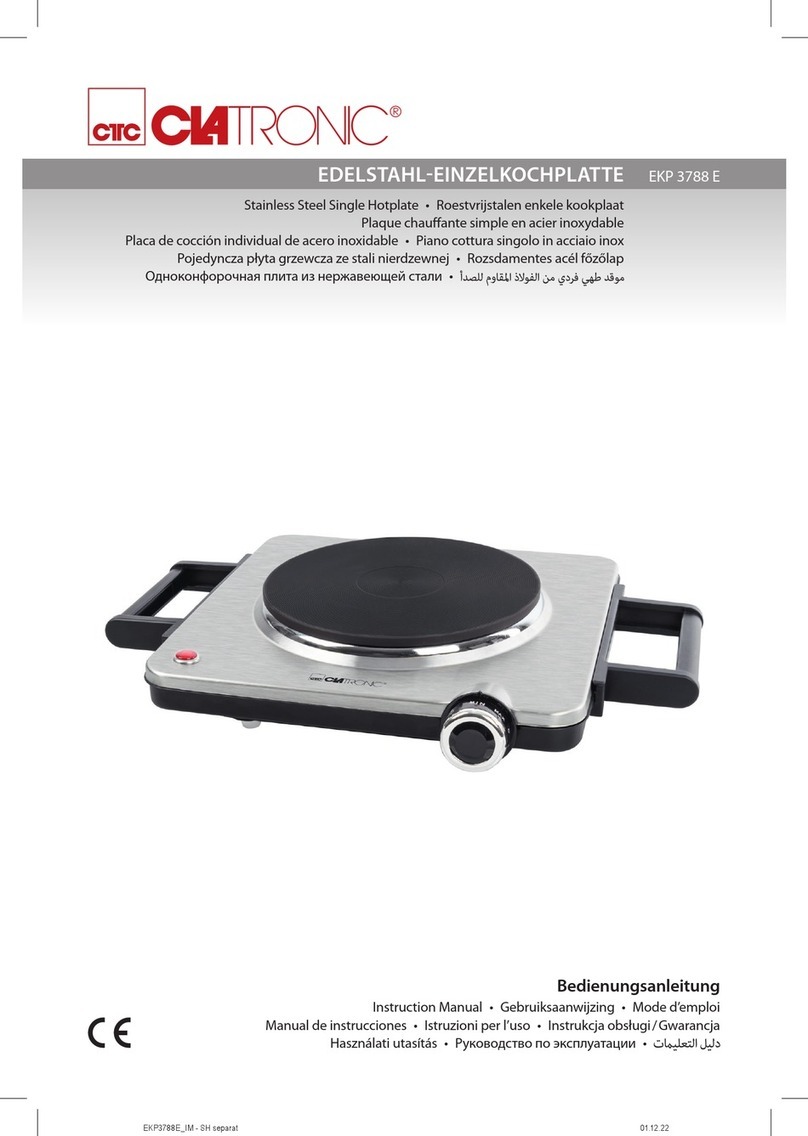
Clatronic
Clatronic EKP 3788 E instruction manual
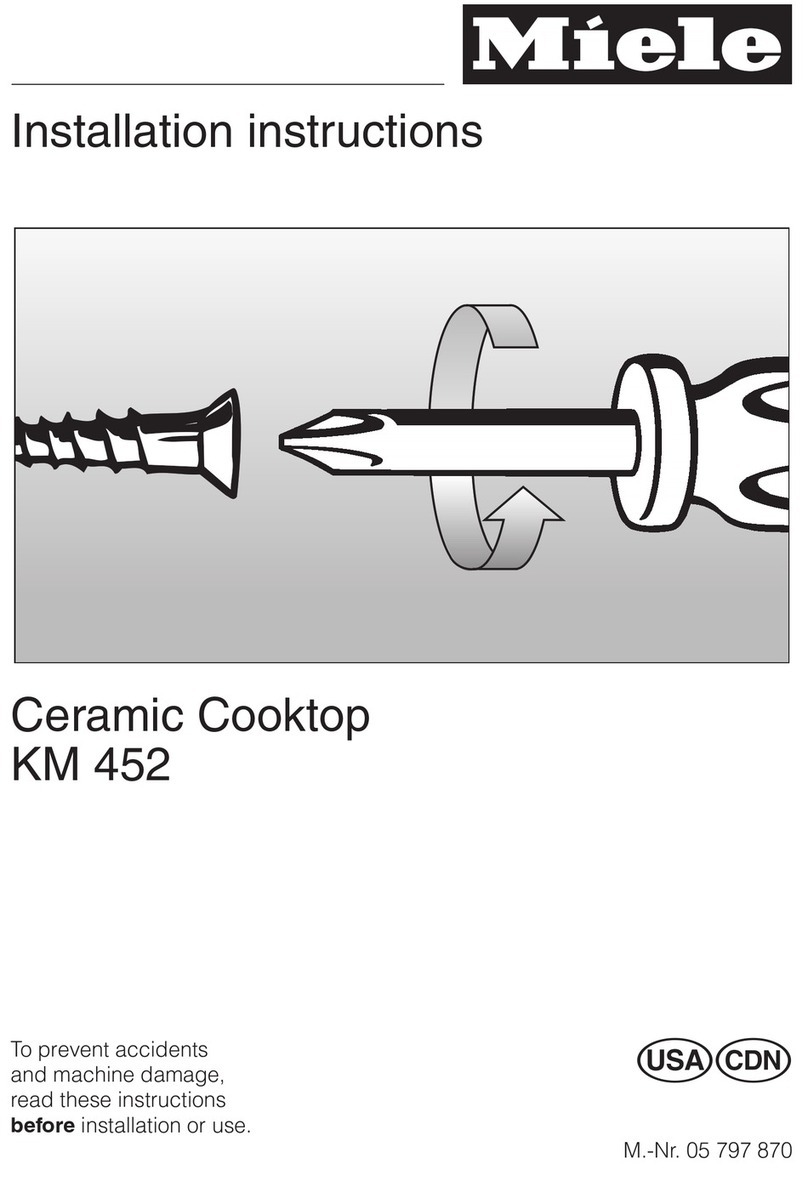
Miele
Miele MasterChef KM452 installation instructions
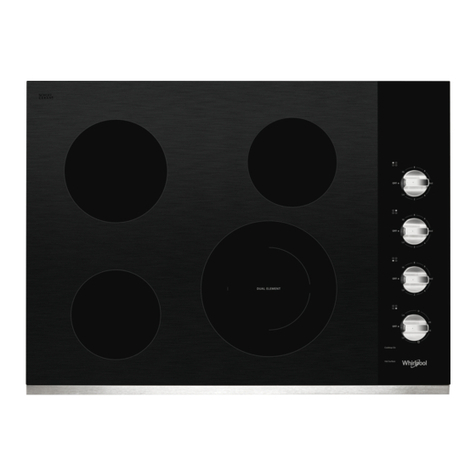
Whirlpool
Whirlpool WCE55US0HS installation instructions
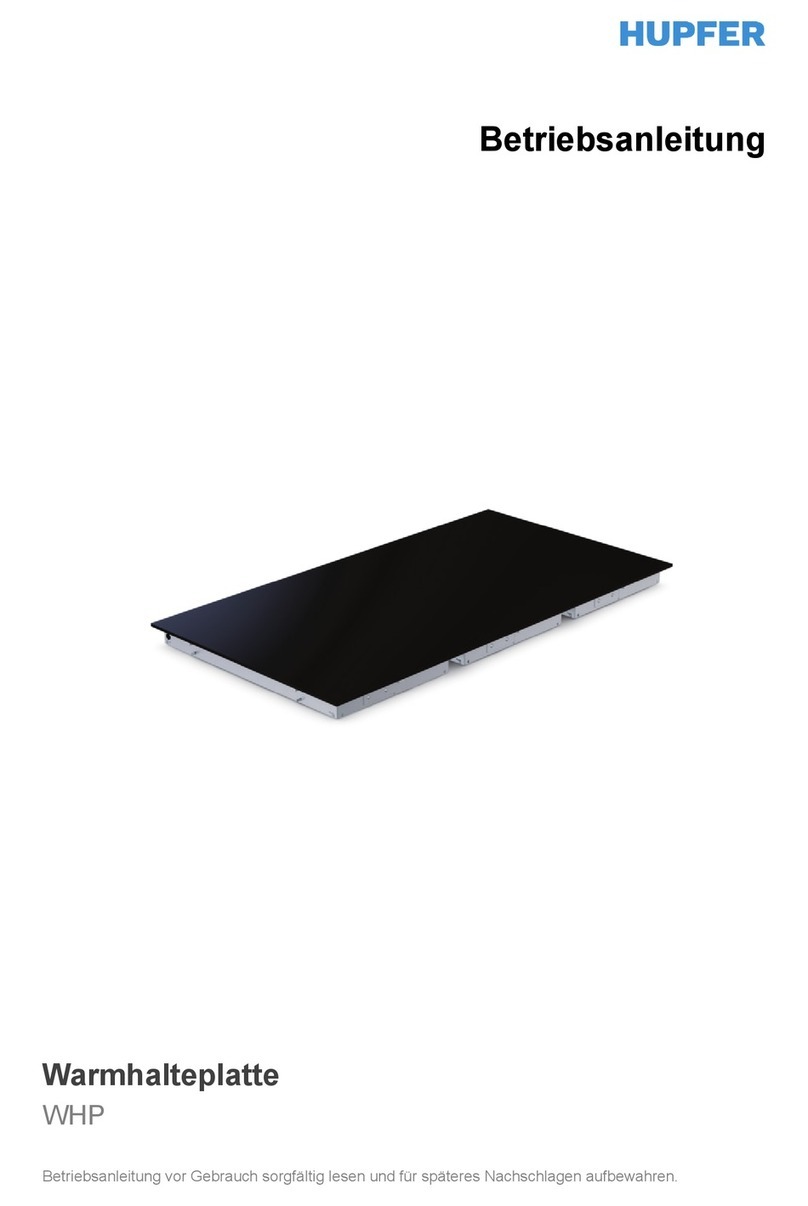
Hupfer
Hupfer WHP Series operating instructions
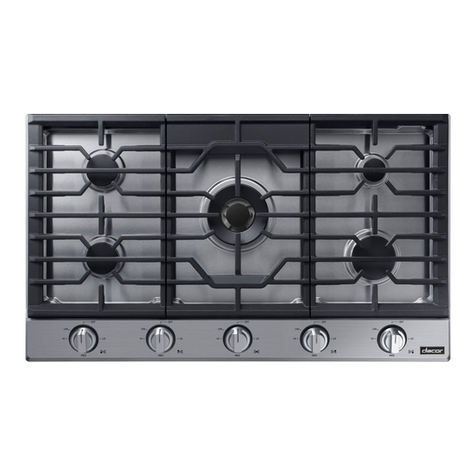
Dacor
Dacor DTG36P875N Series installation manual

Victor
Victor HD60RU manual

Smeg
Smeg Gas Cooktop PA106SX Instructions for installation and use
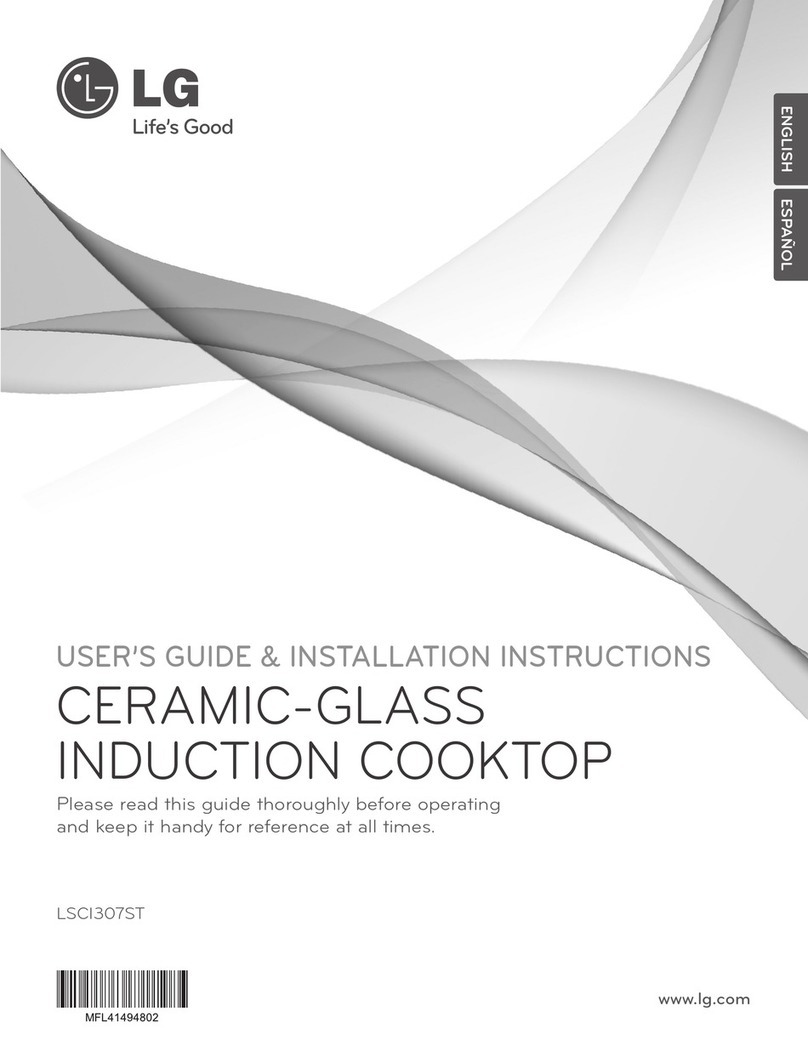
LG
LG Studio LSCI307ST User's guide & installation instructions
